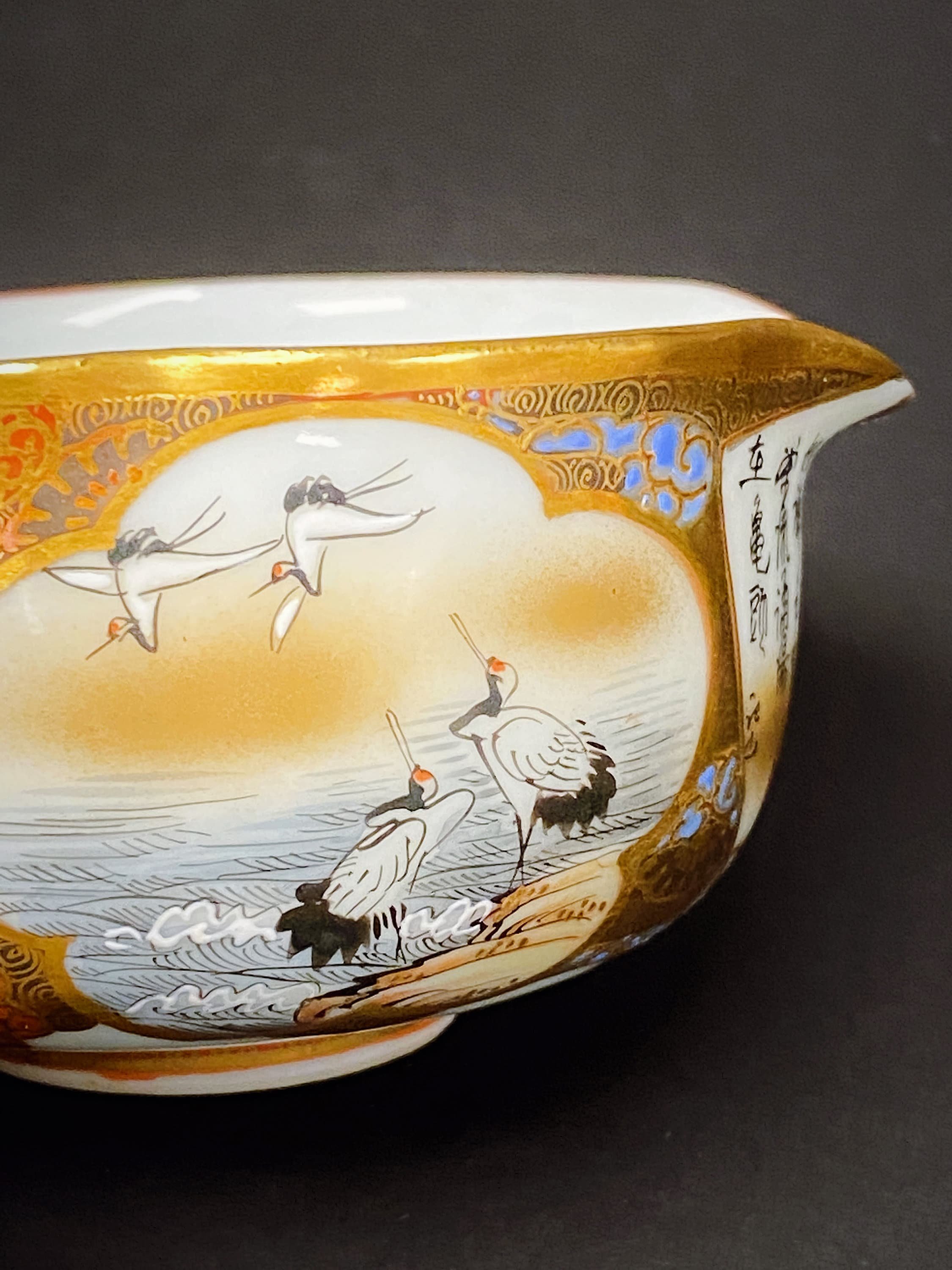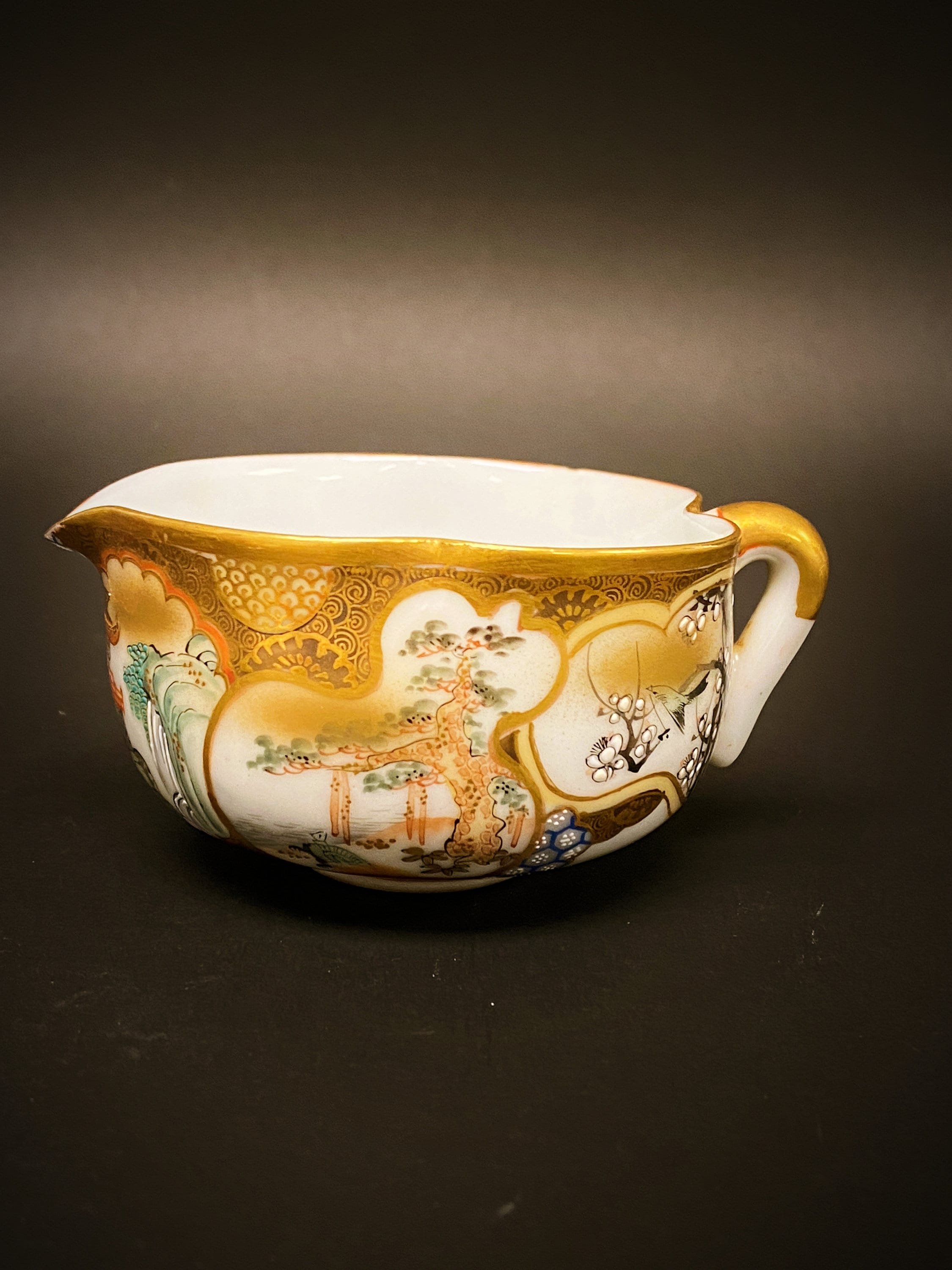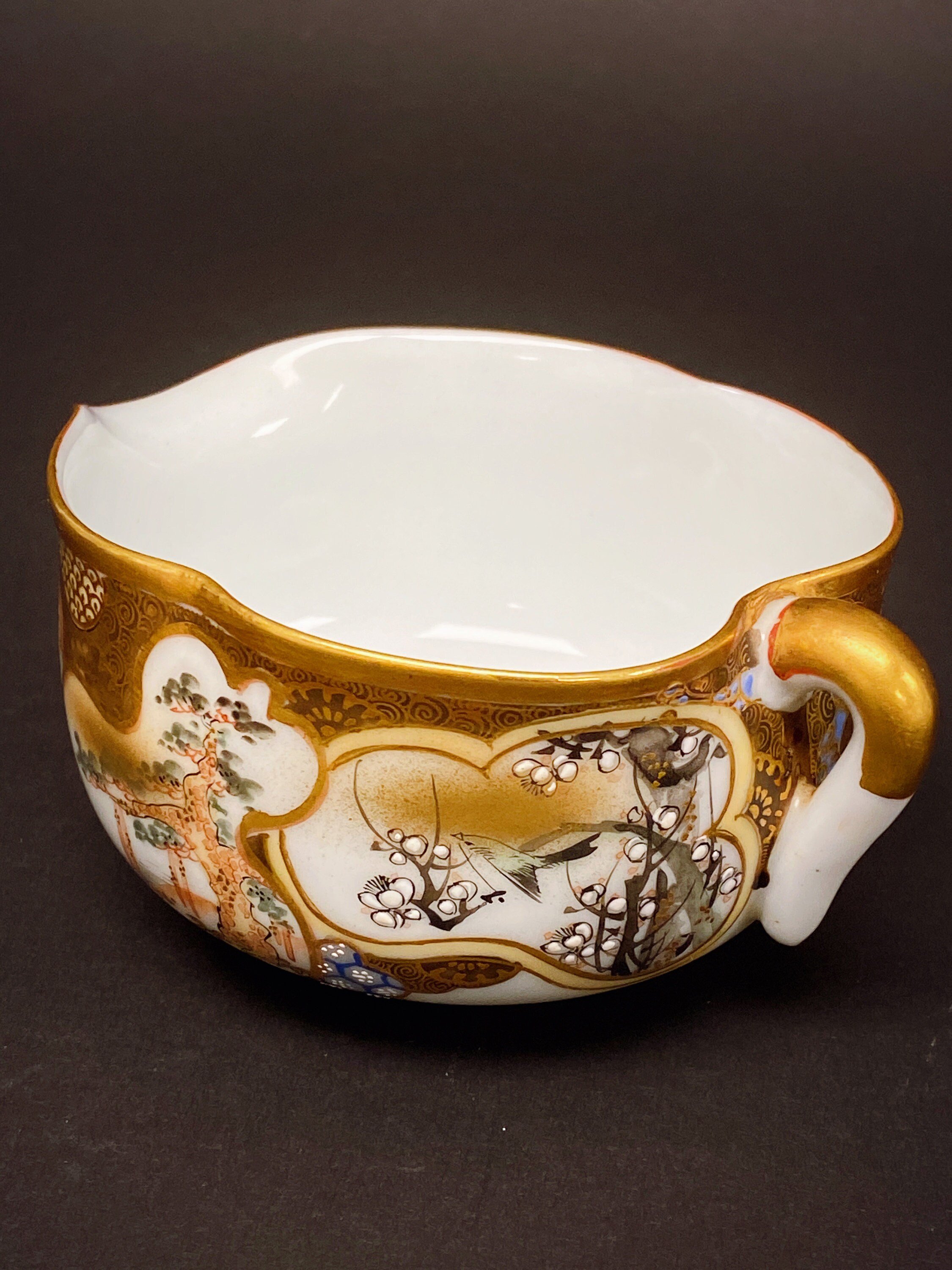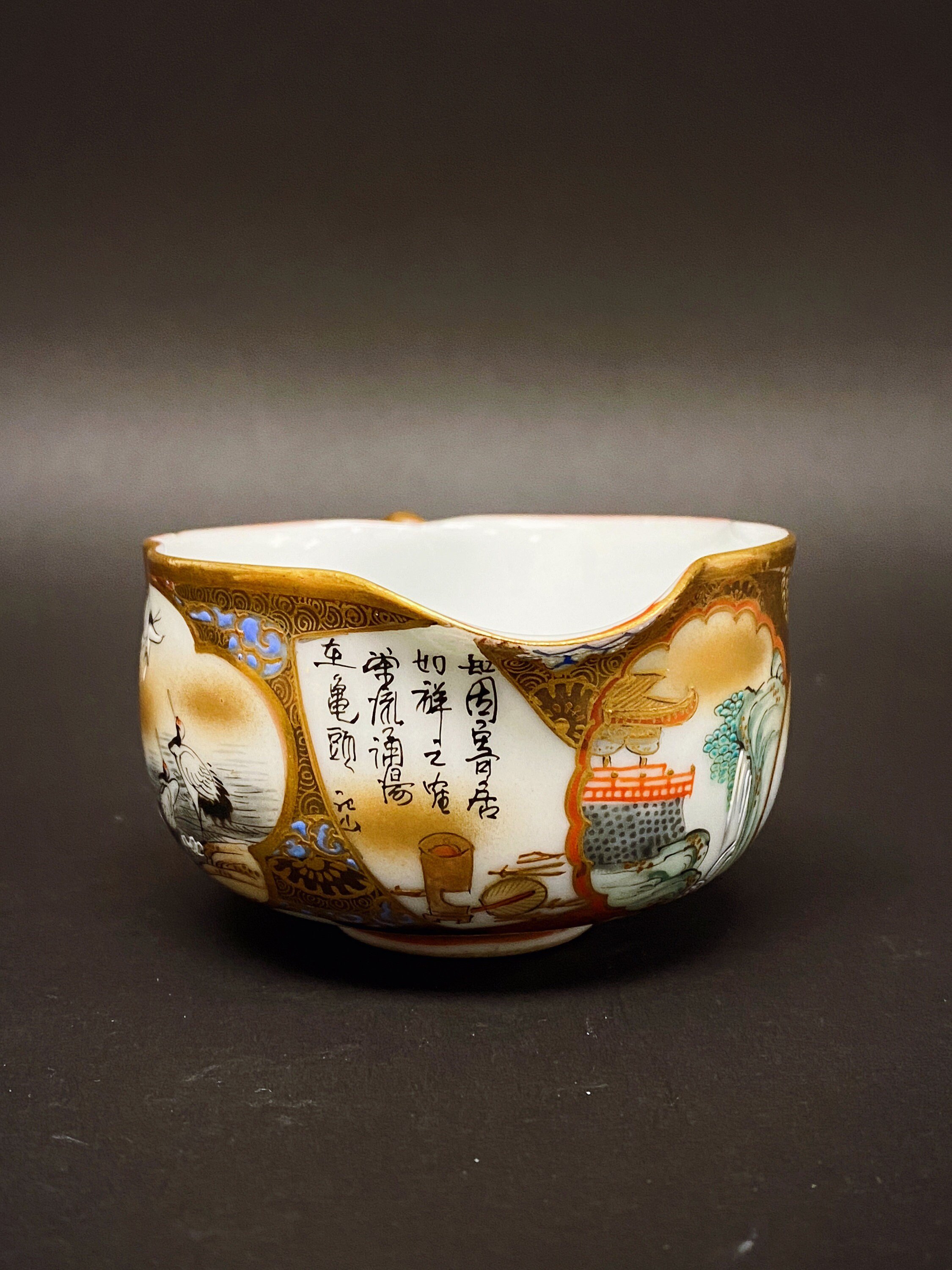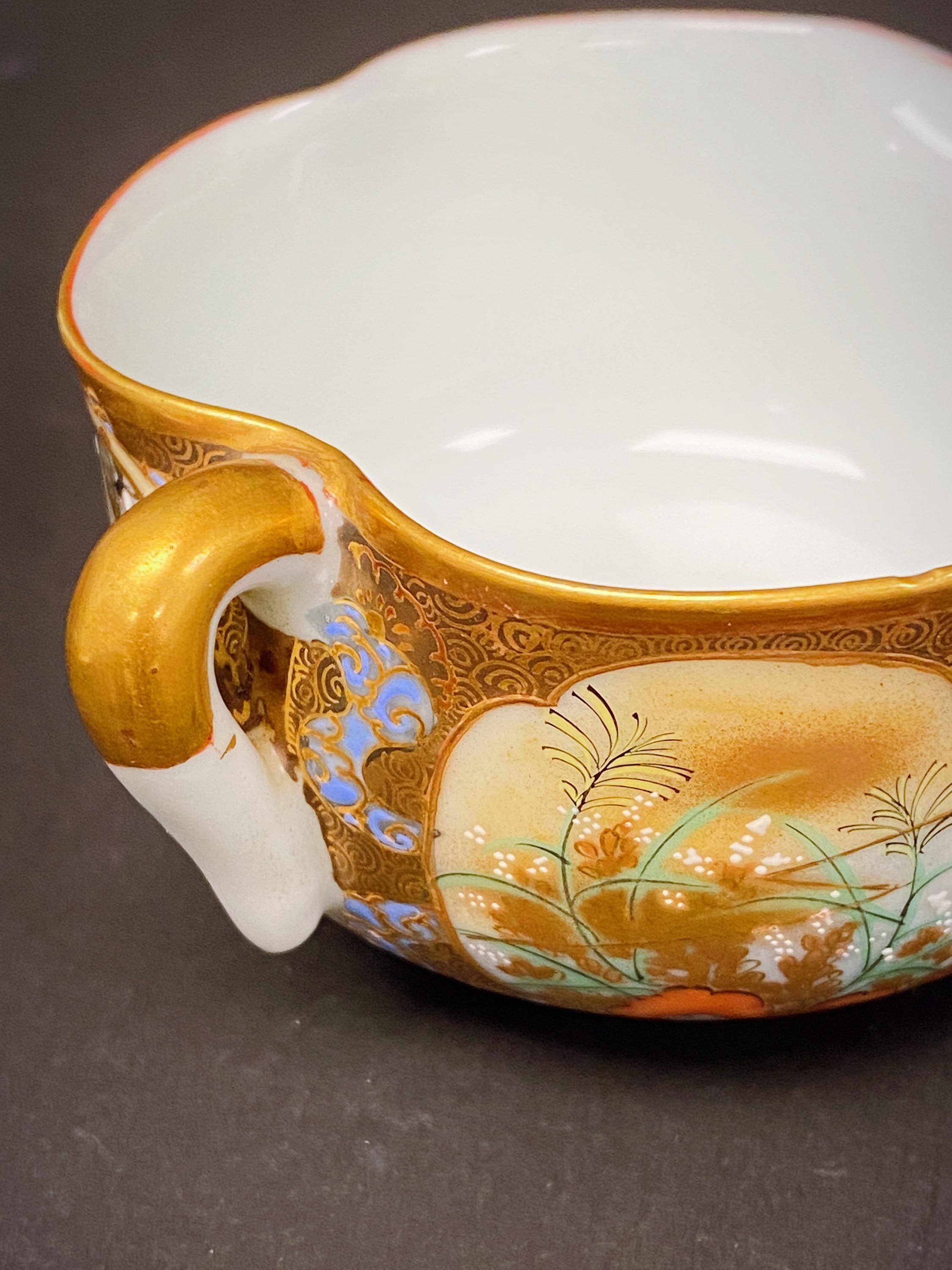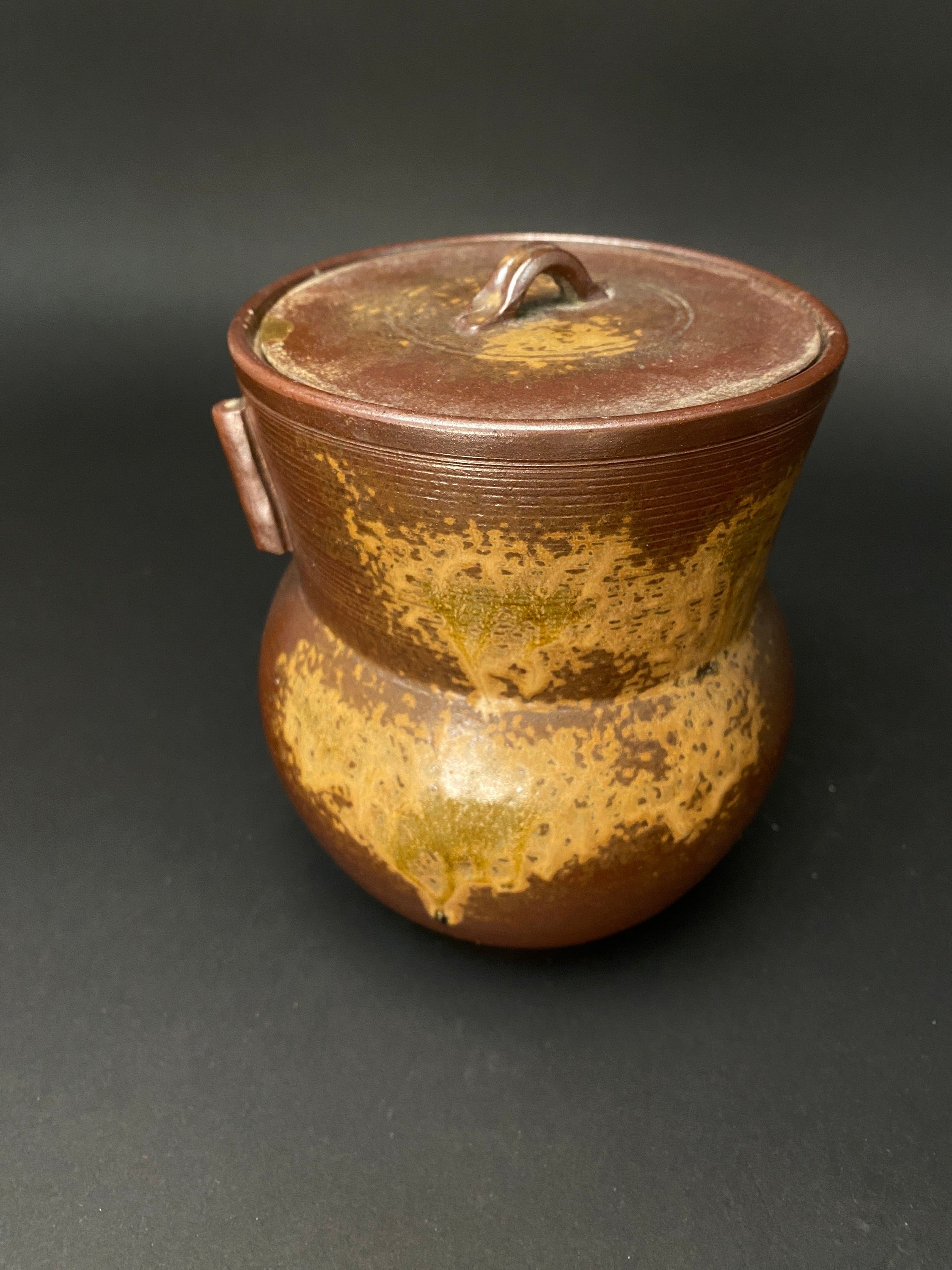Antique Japanese Kutani Satsuma style Porcelain Tea Geisha! Sake Pourer, Creamer, Fair Mug
$256.80
This Kutani Ware porcelain pot was made during the Meiji Period (1868-1912) in Japan and was intended for tea sharing. The design features five large panels depicting cranes, birds, peonies, cherry blossoms, and a poem set in a spring landscape, with gilt flowers and Satsuma-style decorations adorning the warm ground. The pot has a ribbed body, a wire and wound curve handle, and is signed in iron-red on the base using kanji characters, indicating that it was made and painted at the Kutani kilns in Kaga prefecture during the Meiji Period. Additionally, this antique Japanese piece can be used as a Geisha,Sake Pourer , Creamer.
-Simply a wonderful finely decorated Yuhiya/ Tea Geisha!
-It is fully handmade and handpainted Old Kutani Yaki Style Porcelain.
-Pattern: All hand painted Satsuma style.
Details
-No chips or cracks and in excellent condition.
-Colors in images between the item list and the detail page may appear differently in different devices.
-Regarding the definition of ANTIQUE, please refer to the photos
approx. Height2"(5cm) Length 3 1/2"(8cm) Width 2 3/4"(7cm) Weight 8oz
-Japanese Tea Fairness Mug called Yuhiya for cooling down the water and sharing.
-Shipping: Free Domestic Shipping
About Kutani ware
Kutani ware, also known as Kutani-yaki in Japan, is a traditional type of pottery created in and around Kaga city, Ishikawa prefecture. The craft dates back to the early Edo period in the 17th century, and is known for its vibrant colors, intricate designs, and unique overglaze decoration technique. This technique involves painting a pattern on the glazed surface of the pottery with pigments and then firing the piece again. The high firing temperature of about 800℃ (about 1472℉) allows for a wide range of colors to be used. Each type of Kutani ware has its own distinct colors and style.
The history of Kutani ware began in 1655, when the Daishoji clan supported the production of the handicraft in Kutani village. A man named Saijiro GOTO was sent to Arita to learn ceramic-making techniques and brought them back to Kutani. However, the kilns producing this type of pottery were abandoned after only 50 years, with the reasons for their decline still unknown. The ceramics created during this time are referred to as "ko-Kutani" and are known for their beautiful colors and unique designs.
About a century later, Kutani ware production resumed with the support of the feudal domain. Several styles of Kutani ware were created, including Mokubei kiln in 1807, Yoshida-ya kiln in 1827, Iidaya kiln in 1831, Shozan kiln in 1841, and Eiraku kiln in 1865. Today, Kutani ware is still produced in and around Kaga city and is cherished both in Japan and internationally for its beauty and craftsmanship.
-Simply a wonderful finely decorated Yuhiya/ Tea Geisha!
-It is fully handmade and handpainted Old Kutani Yaki Style Porcelain.
-Pattern: All hand painted Satsuma style.
Details
-No chips or cracks and in excellent condition.
-Colors in images between the item list and the detail page may appear differently in different devices.
-Regarding the definition of ANTIQUE, please refer to the photos
approx. Height2"(5cm) Length 3 1/2"(8cm) Width 2 3/4"(7cm) Weight 8oz
-Japanese Tea Fairness Mug called Yuhiya for cooling down the water and sharing.
-Shipping: Free Domestic Shipping
About Kutani ware
Kutani ware, also known as Kutani-yaki in Japan, is a traditional type of pottery created in and around Kaga city, Ishikawa prefecture. The craft dates back to the early Edo period in the 17th century, and is known for its vibrant colors, intricate designs, and unique overglaze decoration technique. This technique involves painting a pattern on the glazed surface of the pottery with pigments and then firing the piece again. The high firing temperature of about 800℃ (about 1472℉) allows for a wide range of colors to be used. Each type of Kutani ware has its own distinct colors and style.
The history of Kutani ware began in 1655, when the Daishoji clan supported the production of the handicraft in Kutani village. A man named Saijiro GOTO was sent to Arita to learn ceramic-making techniques and brought them back to Kutani. However, the kilns producing this type of pottery were abandoned after only 50 years, with the reasons for their decline still unknown. The ceramics created during this time are referred to as "ko-Kutani" and are known for their beautiful colors and unique designs.
About a century later, Kutani ware production resumed with the support of the feudal domain. Several styles of Kutani ware were created, including Mokubei kiln in 1807, Yoshida-ya kiln in 1827, Iidaya kiln in 1831, Shozan kiln in 1841, and Eiraku kiln in 1865. Today, Kutani ware is still produced in and around Kaga city and is cherished both in Japan and internationally for its beauty and craftsmanship.
This Kutani Ware porcelain pot was made during the Meiji Period (1868-1912) in Japan and was intended for tea sharing. The design features five large panels depicting cranes, birds, peonies, cherry blossoms, and a poem set in a spring landscape, with gilt flowers and Satsuma-style decorations adorning the warm ground. The pot has a ribbed body, a wire and wound curve handle, and is signed in iron-red on the base using kanji characters, indicating that it was made and painted at the Kutani kilns in Kaga prefecture during the Meiji Period. Additionally, this antique Japanese piece can be used as a Geisha,Sake Pourer , Creamer.
-Simply a wonderful finely decorated Yuhiya/ Tea Geisha!
-It is fully handmade and handpainted Old Kutani Yaki Style Porcelain.
-Pattern: All hand painted Satsuma style.
Details
-No chips or cracks and in excellent condition.
-Colors in images between the item list and the detail page may appear differently in different devices.
-Regarding the definition of ANTIQUE, please refer to the photos
approx. Height2"(5cm) Length 3 1/2"(8cm) Width 2 3/4"(7cm) Weight 8oz
-Japanese Tea Fairness Mug called Yuhiya for cooling down the water and sharing.
-Shipping: Free Domestic Shipping
About Kutani ware
Kutani ware, also known as Kutani-yaki in Japan, is a traditional type of pottery created in and around Kaga city, Ishikawa prefecture. The craft dates back to the early Edo period in the 17th century, and is known for its vibrant colors, intricate designs, and unique overglaze decoration technique. This technique involves painting a pattern on the glazed surface of the pottery with pigments and then firing the piece again. The high firing temperature of about 800℃ (about 1472℉) allows for a wide range of colors to be used. Each type of Kutani ware has its own distinct colors and style.
The history of Kutani ware began in 1655, when the Daishoji clan supported the production of the handicraft in Kutani village. A man named Saijiro GOTO was sent to Arita to learn ceramic-making techniques and brought them back to Kutani. However, the kilns producing this type of pottery were abandoned after only 50 years, with the reasons for their decline still unknown. The ceramics created during this time are referred to as "ko-Kutani" and are known for their beautiful colors and unique designs.
About a century later, Kutani ware production resumed with the support of the feudal domain. Several styles of Kutani ware were created, including Mokubei kiln in 1807, Yoshida-ya kiln in 1827, Iidaya kiln in 1831, Shozan kiln in 1841, and Eiraku kiln in 1865. Today, Kutani ware is still produced in and around Kaga city and is cherished both in Japan and internationally for its beauty and craftsmanship.
-Simply a wonderful finely decorated Yuhiya/ Tea Geisha!
-It is fully handmade and handpainted Old Kutani Yaki Style Porcelain.
-Pattern: All hand painted Satsuma style.
Details
-No chips or cracks and in excellent condition.
-Colors in images between the item list and the detail page may appear differently in different devices.
-Regarding the definition of ANTIQUE, please refer to the photos
approx. Height2"(5cm) Length 3 1/2"(8cm) Width 2 3/4"(7cm) Weight 8oz
-Japanese Tea Fairness Mug called Yuhiya for cooling down the water and sharing.
-Shipping: Free Domestic Shipping
About Kutani ware
Kutani ware, also known as Kutani-yaki in Japan, is a traditional type of pottery created in and around Kaga city, Ishikawa prefecture. The craft dates back to the early Edo period in the 17th century, and is known for its vibrant colors, intricate designs, and unique overglaze decoration technique. This technique involves painting a pattern on the glazed surface of the pottery with pigments and then firing the piece again. The high firing temperature of about 800℃ (about 1472℉) allows for a wide range of colors to be used. Each type of Kutani ware has its own distinct colors and style.
The history of Kutani ware began in 1655, when the Daishoji clan supported the production of the handicraft in Kutani village. A man named Saijiro GOTO was sent to Arita to learn ceramic-making techniques and brought them back to Kutani. However, the kilns producing this type of pottery were abandoned after only 50 years, with the reasons for their decline still unknown. The ceramics created during this time are referred to as "ko-Kutani" and are known for their beautiful colors and unique designs.
About a century later, Kutani ware production resumed with the support of the feudal domain. Several styles of Kutani ware were created, including Mokubei kiln in 1807, Yoshida-ya kiln in 1827, Iidaya kiln in 1831, Shozan kiln in 1841, and Eiraku kiln in 1865. Today, Kutani ware is still produced in and around Kaga city and is cherished both in Japan and internationally for its beauty and craftsmanship.
This Kutani Ware porcelain pot was made during the Meiji Period (1868-1912) in Japan and was intended for tea sharing. The design features five large panels depicting cranes, birds, peonies, cherry blossoms, and a poem set in a spring landscape, with gilt flowers and Satsuma-style decorations adorning the warm ground. The pot has a ribbed body, a wire and wound curve handle, and is signed in iron-red on the base using kanji characters, indicating that it was made and painted at the Kutani kilns in Kaga prefecture during the Meiji Period. Additionally, this antique Japanese piece can be used as a Geisha,Sake Pourer , Creamer.
-Simply a wonderful finely decorated Yuhiya/ Tea Geisha!
-It is fully handmade and handpainted Old Kutani Yaki Style Porcelain.
-Pattern: All hand painted Satsuma style.
Details
-No chips or cracks and in excellent condition.
-Colors in images between the item list and the detail page may appear differently in different devices.
-Regarding the definition of ANTIQUE, please refer to the photos
approx. Height2"(5cm) Length 3 1/2"(8cm) Width 2 3/4"(7cm) Weight 8oz
-Japanese Tea Fairness Mug called Yuhiya for cooling down the water and sharing.
-Shipping: Free Domestic Shipping
About Kutani ware
Kutani ware, also known as Kutani-yaki in Japan, is a traditional type of pottery created in and around Kaga city, Ishikawa prefecture. The craft dates back to the early Edo period in the 17th century, and is known for its vibrant colors, intricate designs, and unique overglaze decoration technique. This technique involves painting a pattern on the glazed surface of the pottery with pigments and then firing the piece again. The high firing temperature of about 800℃ (about 1472℉) allows for a wide range of colors to be used. Each type of Kutani ware has its own distinct colors and style.
The history of Kutani ware began in 1655, when the Daishoji clan supported the production of the handicraft in Kutani village. A man named Saijiro GOTO was sent to Arita to learn ceramic-making techniques and brought them back to Kutani. However, the kilns producing this type of pottery were abandoned after only 50 years, with the reasons for their decline still unknown. The ceramics created during this time are referred to as "ko-Kutani" and are known for their beautiful colors and unique designs.
About a century later, Kutani ware production resumed with the support of the feudal domain. Several styles of Kutani ware were created, including Mokubei kiln in 1807, Yoshida-ya kiln in 1827, Iidaya kiln in 1831, Shozan kiln in 1841, and Eiraku kiln in 1865. Today, Kutani ware is still produced in and around Kaga city and is cherished both in Japan and internationally for its beauty and craftsmanship.
-Simply a wonderful finely decorated Yuhiya/ Tea Geisha!
-It is fully handmade and handpainted Old Kutani Yaki Style Porcelain.
-Pattern: All hand painted Satsuma style.
Details
-No chips or cracks and in excellent condition.
-Colors in images between the item list and the detail page may appear differently in different devices.
-Regarding the definition of ANTIQUE, please refer to the photos
approx. Height2"(5cm) Length 3 1/2"(8cm) Width 2 3/4"(7cm) Weight 8oz
-Japanese Tea Fairness Mug called Yuhiya for cooling down the water and sharing.
-Shipping: Free Domestic Shipping
About Kutani ware
Kutani ware, also known as Kutani-yaki in Japan, is a traditional type of pottery created in and around Kaga city, Ishikawa prefecture. The craft dates back to the early Edo period in the 17th century, and is known for its vibrant colors, intricate designs, and unique overglaze decoration technique. This technique involves painting a pattern on the glazed surface of the pottery with pigments and then firing the piece again. The high firing temperature of about 800℃ (about 1472℉) allows for a wide range of colors to be used. Each type of Kutani ware has its own distinct colors and style.
The history of Kutani ware began in 1655, when the Daishoji clan supported the production of the handicraft in Kutani village. A man named Saijiro GOTO was sent to Arita to learn ceramic-making techniques and brought them back to Kutani. However, the kilns producing this type of pottery were abandoned after only 50 years, with the reasons for their decline still unknown. The ceramics created during this time are referred to as "ko-Kutani" and are known for their beautiful colors and unique designs.
About a century later, Kutani ware production resumed with the support of the feudal domain. Several styles of Kutani ware were created, including Mokubei kiln in 1807, Yoshida-ya kiln in 1827, Iidaya kiln in 1831, Shozan kiln in 1841, and Eiraku kiln in 1865. Today, Kutani ware is still produced in and around Kaga city and is cherished both in Japan and internationally for its beauty and craftsmanship.


